Abstract
1. We have examined the effects of five different lung surfactant factor (LSF) preparations in the rat lung lavage model. In this model repetitive lung lavage leads to lung injury with some similarities to adult respiratory distress syndrome with poor gas exchange and protein leakage into the alveolar spaces. These pathological sequelae can be reversed by LSF instillation soon after lavage. 2. The tested LSF preparations were: two bovine: Survanta and Alveofact: two synthetic: Exosurf and a protein-free phospholipid based LSF (PL-LSF) and one Recombinant LSF at doses of 25, 50 and 100 mg kg-1 body weight and an untreated control group. 3. Tracheotomized rats (10-12 per dose) were pressure-controlled ventilated (Siemens Servo Ventilator 900C) with 100% oxygen at a respiratory rate of 30 breaths min-1, inspiration expiration ratio of 1:2, peak inspiratory pressure (PIP) of 28 cmH2O at positive end-expiratory pressure (PEEP) of 8 cmH2O. Two hours after LSF administration, PEEP and in parallel PIP was reduced from 8 to 6 (1st reduction), from 6 to 3 (2nd reduction) and from 3 to 0 cmH2O (3rd reduction). 4. Partial arterial oxygen pressure (PaO2, mmHg) at 5 min and 120 min after LSF administration and during the 2nd PEEP reduction (PaO2(PEEP23/3)) were used for statistical comparison. All LSF preparations caused a dose-dependent increase for the PaO2(120'), whereas during the 2nd PEEP reduction only bovine and recombinant LSF exhibited dose-dependency. Exosurf did not increase PaO2 after administration of the highest dose. At the highest dose Exosurf exerted no further improvement but rather a tendency to relapse.(ABSTRACT TRUNCATED AT 250 WORDS)
Full text
PDF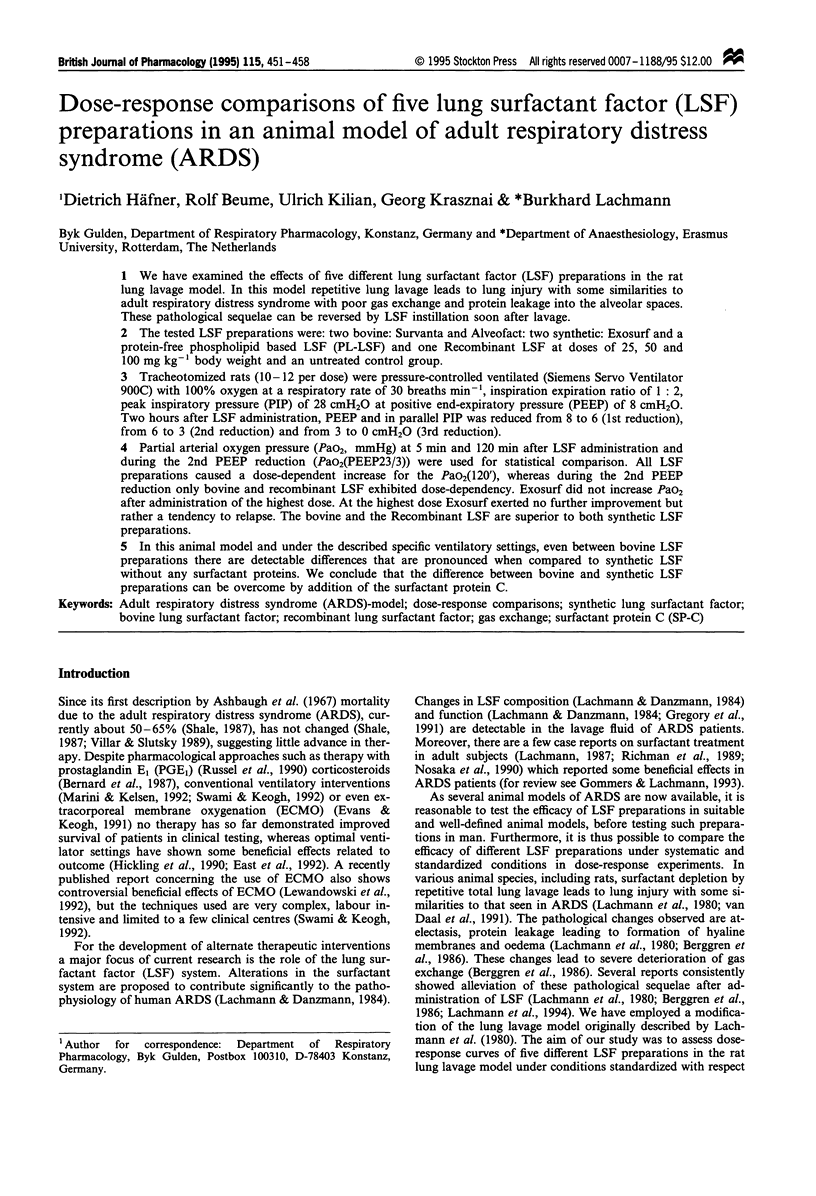
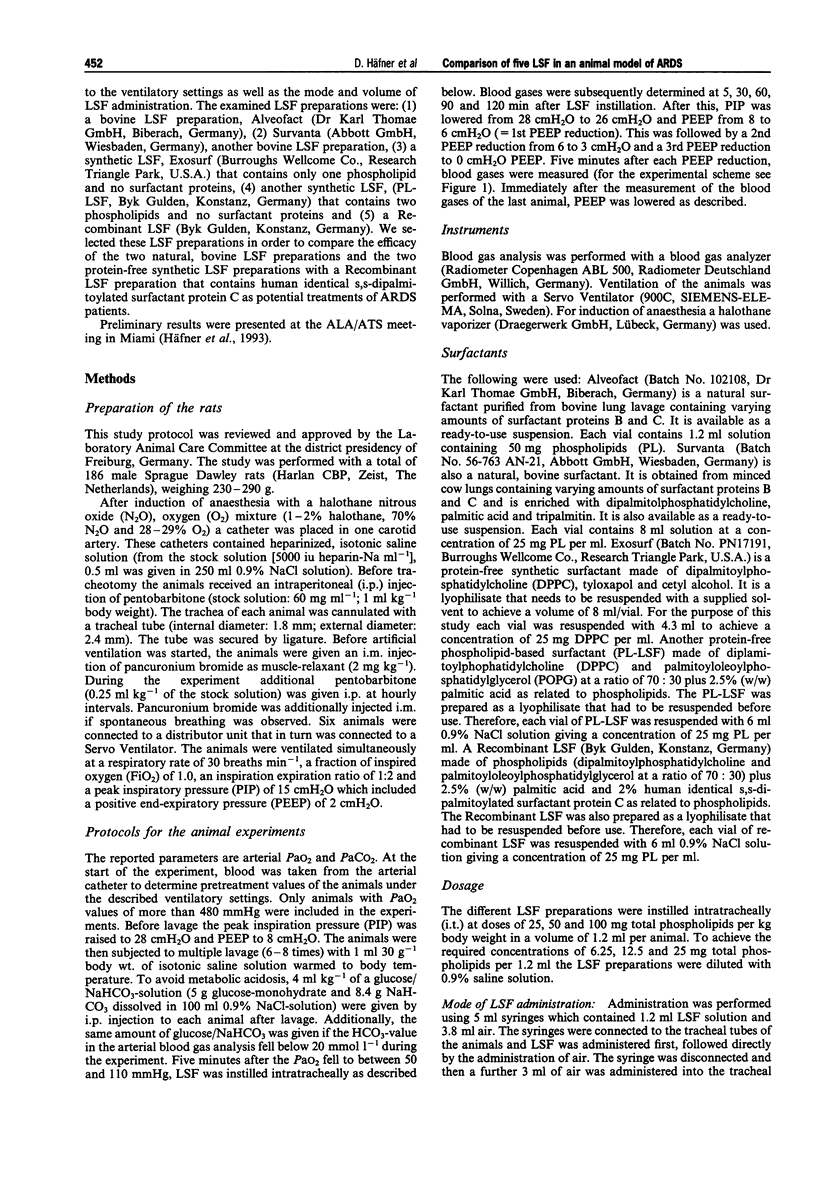
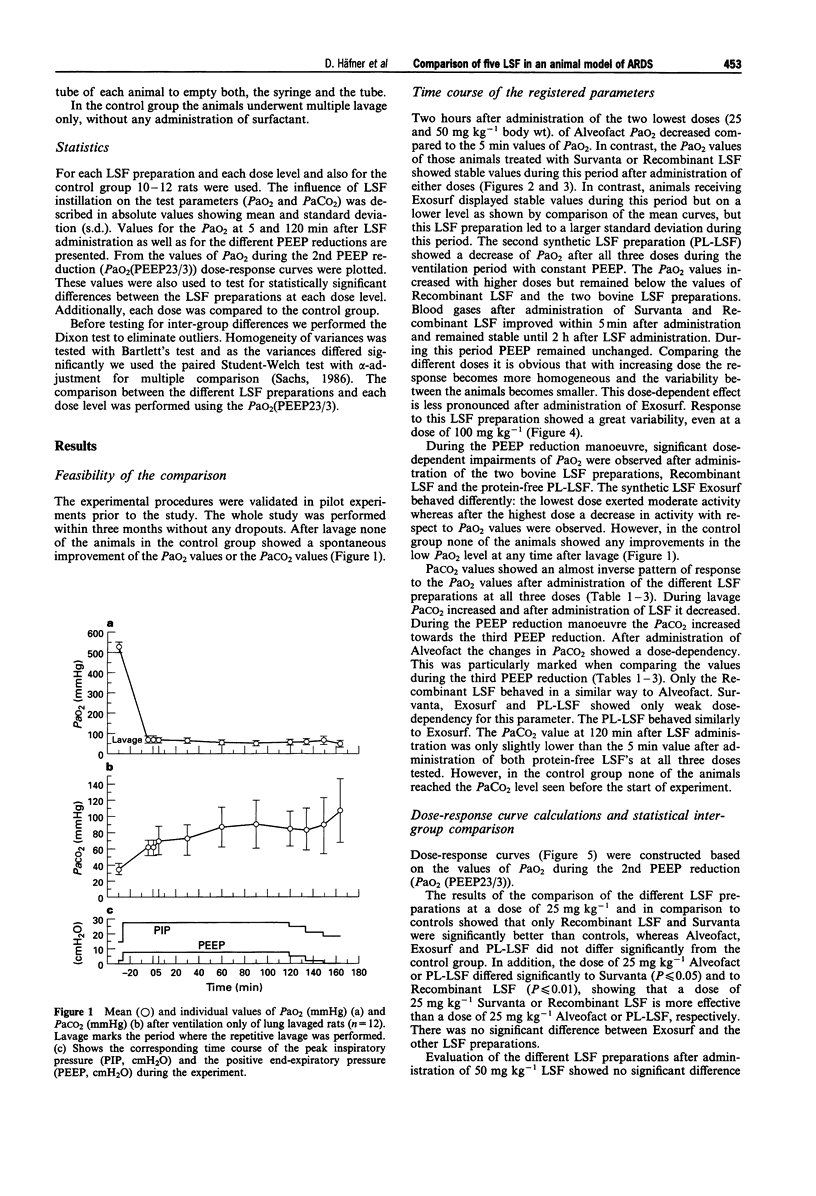
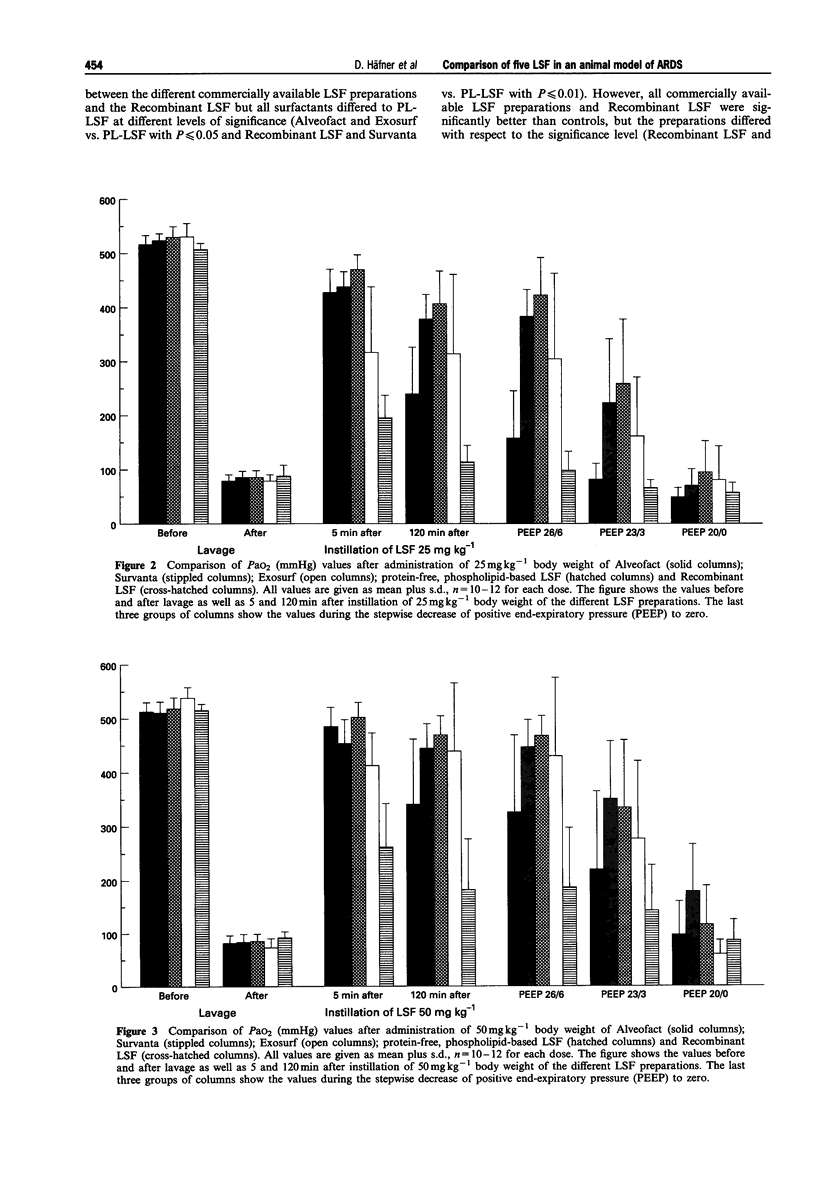
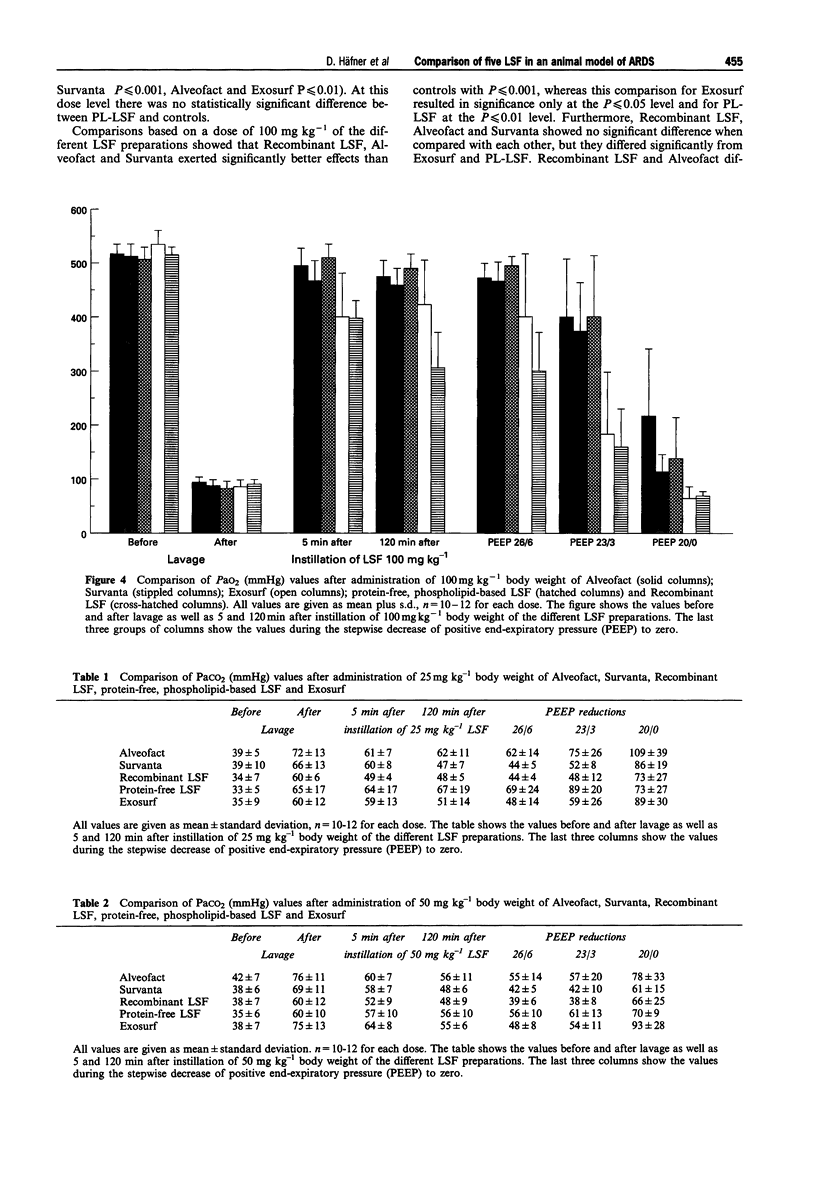
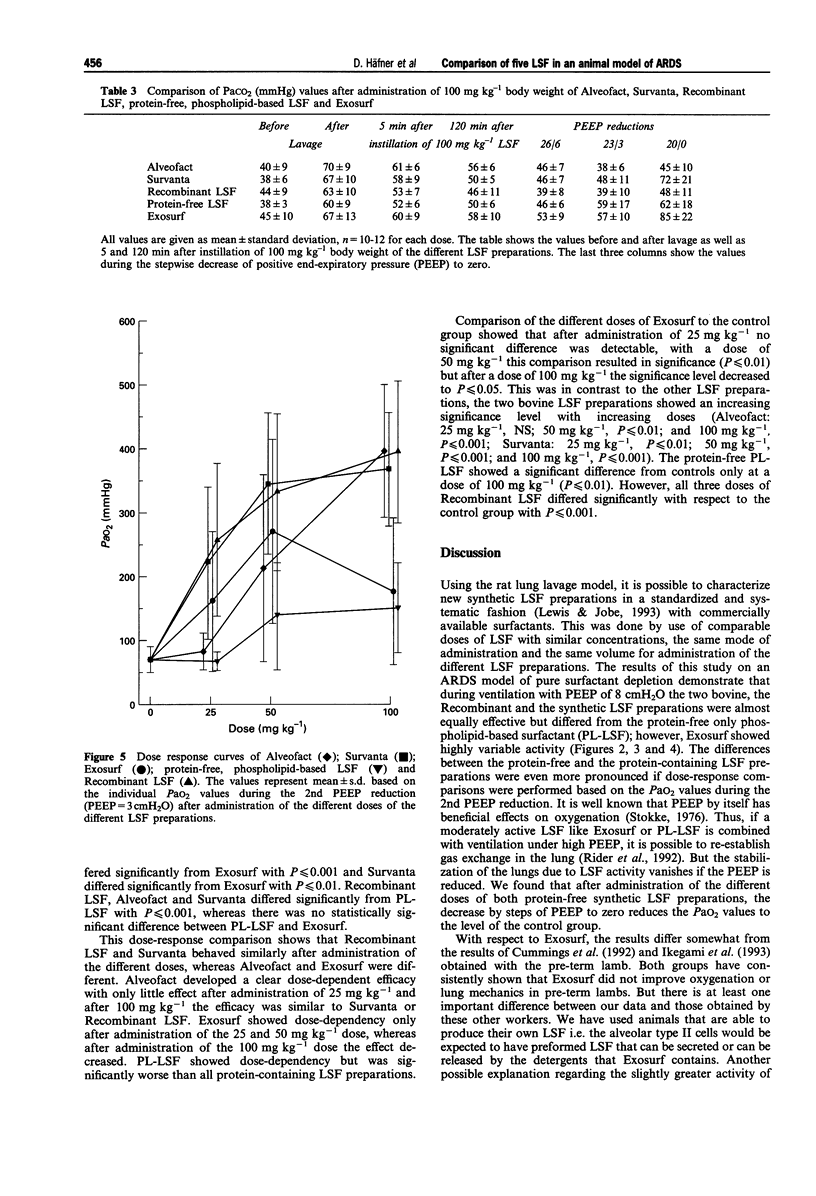
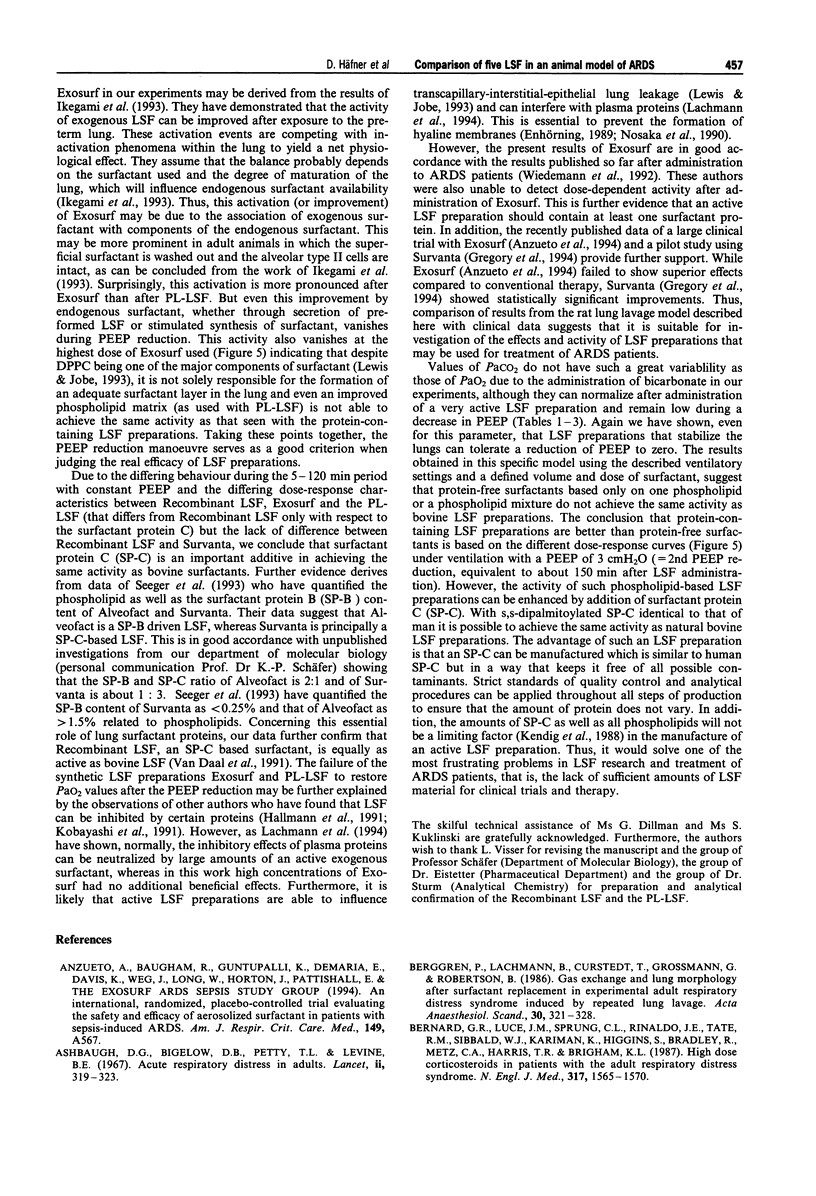
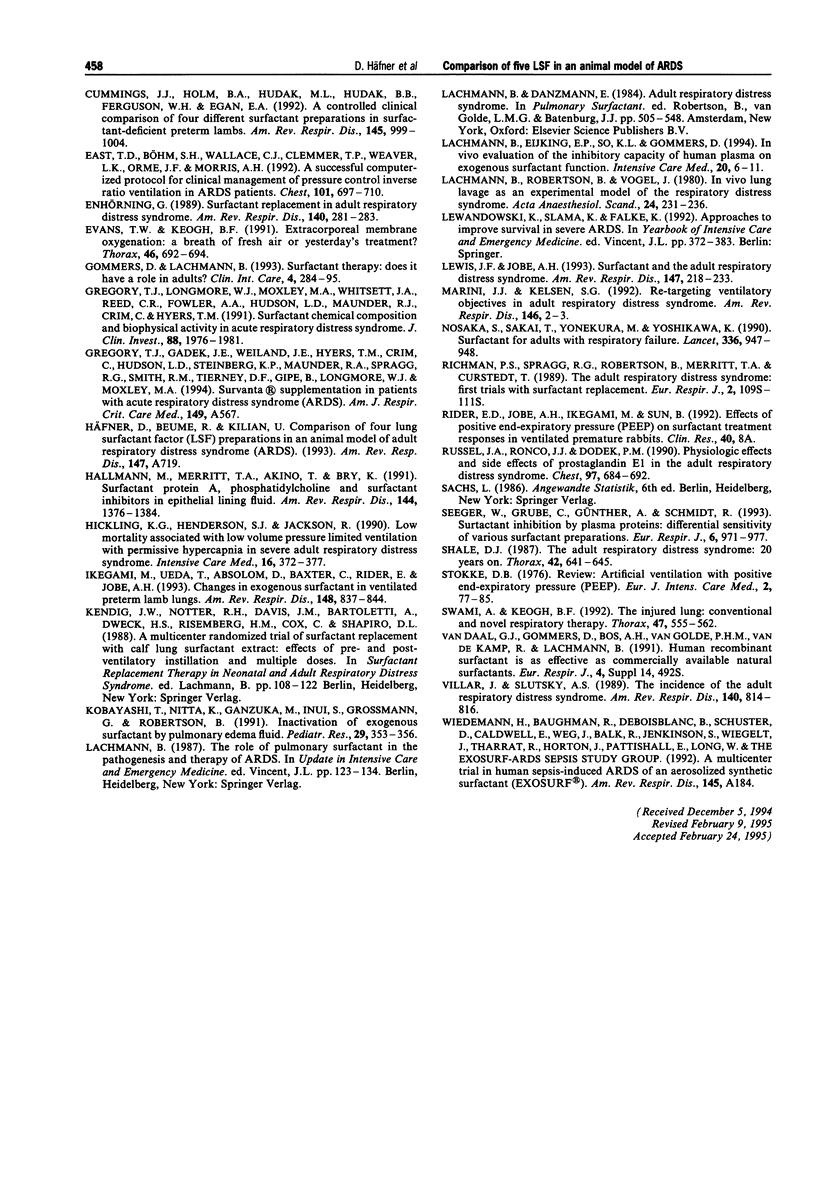
Images in this article
Selected References
These references are in PubMed. This may not be the complete list of references from this article.
- Ashbaugh D. G., Bigelow D. B., Petty T. L., Levine B. E. Acute respiratory distress in adults. Lancet. 1967 Aug 12;2(7511):319–323. doi: 10.1016/s0140-6736(67)90168-7. [DOI] [PubMed] [Google Scholar]
- Berggren P., Lachmann B., Curstedt T., Grossmann G., Robertson B. Gas exchange and lung morphology after surfactant replacement in experimental adult respiratory distress syndrome induced by repeated lung lavage. Acta Anaesthesiol Scand. 1986 May;30(4):321–328. doi: 10.1111/j.1399-6576.1986.tb02423.x. [DOI] [PubMed] [Google Scholar]
- Bernard G. R., Luce J. M., Sprung C. L., Rinaldo J. E., Tate R. M., Sibbald W. J., Kariman K., Higgins S., Bradley R., Metz C. A. High-dose corticosteroids in patients with the adult respiratory distress syndrome. N Engl J Med. 1987 Dec 17;317(25):1565–1570. doi: 10.1056/NEJM198712173172504. [DOI] [PubMed] [Google Scholar]
- Cummings J. J., Holm B. A., Hudak M. L., Hudak B. B., Ferguson W. H., Egan E. A. A controlled clinical comparison of four different surfactant preparations in surfactant-deficient preterm lambs. Am Rev Respir Dis. 1992 May;145(5):999–1004. doi: 10.1164/ajrccm/145.5.999. [DOI] [PubMed] [Google Scholar]
- East T. D., Böhm S. H., Wallace C. J., Clemmer T. P., Weaver L. K., Orme J. F., Jr, Morris A. H. A successful computerized protocol for clinical management of pressure control inverse ratio ventilation in ARDS patients. Chest. 1992 Mar;101(3):697–710. doi: 10.1378/chest.101.3.697. [DOI] [PubMed] [Google Scholar]
- Enhorning G. Surfactant replacement in adult respiratory distress syndrome. Am Rev Respir Dis. 1989 Aug;140(2):281–283. doi: 10.1164/ajrccm/140.2.281. [DOI] [PubMed] [Google Scholar]
- Evans T. W., Keogh B. F. Extracorporeal membrane oxygenation: a breath of fresh air or yesterday's treatment? Thorax. 1991 Oct;46(10):692–694. doi: 10.1136/thx.46.10.692. [DOI] [PMC free article] [PubMed] [Google Scholar]
- Gregory T. J., Longmore W. J., Moxley M. A., Whitsett J. A., Reed C. R., Fowler A. A., 3rd, Hudson L. D., Maunder R. J., Crim C., Hyers T. M. Surfactant chemical composition and biophysical activity in acute respiratory distress syndrome. J Clin Invest. 1991 Dec;88(6):1976–1981. doi: 10.1172/JCI115523. [DOI] [PMC free article] [PubMed] [Google Scholar]
- Hallman M., Merritt T. A., Akino T., Bry K. Surfactant protein A, phosphatidylcholine, and surfactant inhibitors in epithelial lining fluid. Correlation with surface activity, severity of respiratory distress syndrome, and outcome in small premature infants. Am Rev Respir Dis. 1991 Dec;144(6):1376–1384. doi: 10.1164/ajrccm/144.6.1376. [DOI] [PubMed] [Google Scholar]
- Hickling K. G., Henderson S. J., Jackson R. Low mortality associated with low volume pressure limited ventilation with permissive hypercapnia in severe adult respiratory distress syndrome. Intensive Care Med. 1990;16(6):372–377. doi: 10.1007/BF01735174. [DOI] [PubMed] [Google Scholar]
- Ikegami M., Ueda T., Absolom D., Baxter C., Rider E., Jobe A. H. Changes in exogenous surfactant in ventilated preterm lamb lungs. Am Rev Respir Dis. 1993 Oct;148(4 Pt 1):837–844. doi: 10.1164/ajrccm/148.4_Pt_1.837. [DOI] [PubMed] [Google Scholar]
- Kobayashi T., Nitta K., Ganzuka M., Inui S., Grossmann G., Robertson B. Inactivation of exogenous surfactant by pulmonary edema fluid. Pediatr Res. 1991 Apr;29(4 Pt 1):353–356. doi: 10.1203/00006450-199104000-00005. [DOI] [PubMed] [Google Scholar]
- Lachmann B., Eijking E. P., So K. L., Gommers D. In vivo evaluation of the inhibitory capacity of human plasma on exogenous surfactant function. Intensive Care Med. 1994;20(1):6–11. doi: 10.1007/BF02425047. [DOI] [PubMed] [Google Scholar]
- Lachmann B., Robertson B., Vogel J. In vivo lung lavage as an experimental model of the respiratory distress syndrome. Acta Anaesthesiol Scand. 1980 Jun;24(3):231–236. doi: 10.1111/j.1399-6576.1980.tb01541.x. [DOI] [PubMed] [Google Scholar]
- Lewis J. F., Jobe A. H. Surfactant and the adult respiratory distress syndrome. Am Rev Respir Dis. 1993 Jan;147(1):218–233. doi: 10.1164/ajrccm/147.1.218. [DOI] [PubMed] [Google Scholar]
- Marini J. J., Kelsen S. G. Re-targeting ventilatory objectives in adult respiratory distress syndrome. New treatment prospects--persistent questions. Am Rev Respir Dis. 1992 Jul;146(1):2–3. doi: 10.1164/ajrccm/146.1.2. [DOI] [PubMed] [Google Scholar]
- Nosaka S., Sakai T., Yonekura M., Yoshikawa K. Surfactant for adults with respiratory failure. Lancet. 1990 Oct 13;336(8720):947–948. doi: 10.1016/0140-6736(90)92325-c. [DOI] [PubMed] [Google Scholar]
- Richman P. S., Spragg R. G., Robertson B., Merritt T. A., Curstedt T. The adult respiratory distress syndrome: first trials with surfactant replacement. Eur Respir J Suppl. 1989 Mar;3:109s–111s. [PubMed] [Google Scholar]
- Russell J. A., Ronco J. J., Dodek P. M. Physiologic effects and side effects of prostaglandin E1 in the adult respiratory distress syndrome. Chest. 1990 Mar;97(3):684–692. doi: 10.1378/chest.97.3.684. [DOI] [PubMed] [Google Scholar]
- Seeger W., Grube C., Günther A., Schmidt R. Surfactant inhibition by plasma proteins: differential sensitivity of various surfactant preparations. Eur Respir J. 1993 Jul;6(7):971–977. [PubMed] [Google Scholar]
- Shale D. J. The adult respiratory distress syndrome--20 years on. Thorax. 1987 Sep;42(9):641–645. doi: 10.1136/thx.42.9.641. [DOI] [PMC free article] [PubMed] [Google Scholar]
- Stokke D. B. Review: artifical ventilation with positive end-expiratory pressure (PEEP). Historical background, terminology and patho-physiology. Eur J Intensive Care Med. 1976 Sep;2(2):77–85. doi: 10.1007/BF01886120. [DOI] [PubMed] [Google Scholar]
- Swami A., Keogh B. F. The pulmonary physician and critical care. 2. The injured lung: conventional and novel respiratory therapy. Thorax. 1992 Jul;47(7):555–562. doi: 10.1136/thx.47.7.555. [DOI] [PMC free article] [PubMed] [Google Scholar]
- Villar J., Slutsky A. S. The incidence of the adult respiratory distress syndrome. Am Rev Respir Dis. 1989 Sep;140(3):814–816. doi: 10.1164/ajrccm/140.3.814. [DOI] [PubMed] [Google Scholar]





